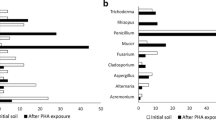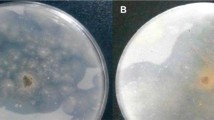PHB (poly-3-hydroxybutyric acid) is a thermoplastic polyester synthesized by Ralstonia eutropha and other bacteria as a form of intracellular carbon and energy storage and accumulated as inclusions in the cytoplasm of these bacteria. The degradation of PHB by fungi from samples collected from various environments was studied. PHB depolymerization was tested in vials containing a PHB-containing medium which were inoculated with isolates from the samples. The degradation activity was detected by the formation of a clear zone below and around the fungal colony. In total, 105 fungi were isolated from 15 natural habitats and 8 lichens, among which 41 strains showed PHB degradation. Most of these were deuteromycetes (fungi imperfecti) resembling species of Penicillium and Aspergillus and were isolated mostly from soils, compost, hay, and lichens. Soil-containing environments were the habitats from which the largest number of fungal PHB degraders were found. Other organisms involved in PHB degradation were observed. A total number of 31 bacterial strains out of 67 isolates showed clear zones on assay medium. Protozoa, possible PHB degraders, were also found in several samples such as pond, soil, hay, horse dung, and lichen. Lichen, a fungi and algae symbiosis, was an unexpected sample from which fungal and bacterial PHB degraders were isolated.
Similar content being viewed by others
References
M. Matavulj H. P. Molitoris (1992) FEMS Microbiol. Rev 103 323–331 Occurrence Handle10.1016/0378-1097(92)90326-J
S. Y. Lee (1996b) Trends Biotechnol 14 431–438 Occurrence Handle10.1016/0167-7799(96)10061-5
V. C. Kalia N. Raizada V. Sonakya (2000) J. Sci. Indust. Res 59 433–445
W. J. Page (1995) Can. J. Microbiol 41 IssueIDSuppl. 1 1–3
H. Brandl P. Puchner (1992) Biodegradation 2 237–243 Occurrence Handle10.1007/BF00114555
G. Swift (1993) Acc. Chem. Res 26 105–110 Occurrence Handle10.1021/ar00027a005
D. Y. Kim Y. H. Rhee (2003) Appl. Microbiol. Biotechnol 61 300–308 Occurrence Handle12743758
B.-I Sang K. Hori Y. Tanji H. Unno (2002) Appl. Microbiol. Biotechnol 58 241–247 Occurrence Handle10.1007/s00253-001-0884-5 Occurrence Handle11876418
K. E. Gonda D. Jendrossek H. P. Molitoris (2000) Hydrobiologia 426 173–183 Occurrence Handle10.1023/A:1003971925285
M.-N. Kim A.-R. Lee J.-S. Yoon I.-J. Chin (2000c) Eur. Polym. J 36 1677–1685 Occurrence Handle10.1016/S0014-3057(99)00219-0
J. Mergaert S. J. Swing (1996) J. Indust. Microbiol 17 463–469 Occurrence Handle10.1007/BF01574777
D. F. Gilmore S. Antoun R. W. Lenz S. Goodwin R. Austin (1992) J. Indust. Microbiol 10 119–206
H. Brandl R. Bachofen J. Mayer E. Wintermantel (1995) Can. J. Microbiol 41 IssueIDSuppl. 1 143–153
I. A. Ramsay E. Berger B. A. Ramsay C. Chavarie (1990) Biotechnol. Tech 4 221–226 Occurrence Handle10.1007/BF00158833
H. Brandl R. A. Gross R. W. Lenz R. C. Fuller (1988) Appl. Environ. Microbiol 54 1977–1982
V. Ahmadjian (1993) The Lichen Symbiosis John Wiley & Sons Inc. New York
J. Augusta R. J. Muller J. Widdecke (1993) Appl. Microbiol. Biotechnol 39 673–678 Occurrence Handle10.1007/BF00205073
J. Mergaert A. Webb C. Anderson A. Wouters S. J. Swing (1993) Appl. Environ. Microbiol 59 3233–3238 Occurrence Handle8250550
P. D. Crittenden J. C. David D. L. Hawksworth F. S. Cambell (1995) New Phytol 130 267–297
H. Brandl R. A. Gross R. W. Lenz R. C. Fuller (1990) Adv. Biochem. Eng. Biotechnol 41 77–93 Occurrence Handle2126418
J. Mergaert G. Gorieus L. Hauben V. Storms M. Mau J. Swings (1996) Syst. Appl. Microbiol 19 407–413
R. Honegger (1991) Annu. Rev. Plant Physiol. Plant Mol. Biol 42 553–578 Occurrence Handle10.1146/annurev.pp.42.060191.003005
R. Honegger (1993) New Phytol 125 659–677
J. D. Lawrey (1995) Rev. Can. J. Bot 73 IssueIDSuppl. 1 s603–s608
O. Petrini U. Hake M. M. Dreyfuss (1990) Mycologia 82 444–451
D. L. Hawksworth (1982) J. Hattori Bot. Lab 52 377–366
C. J. Alexooulos C. W. Mims M. Blackwell (1996) Introductory Mycology EditionNumber4th ed. John Wiley & Sons Inc. New York 382–391
T. D. Brock M. T. Madigan J. M. Martinko J. Parker (1994) Biology of Microorganisms EditionNumber7th ed. Prentice Hall Upper Saddle River, New Jersey 648–650
P. D. Crittenden N. Porter (1991) Tibtech 9 409–414
A. C. Palmisano C. A. Pettigrew (1992) Bioscience 42 680–685
Author information
Authors and Affiliations
Corresponding author
Additional information
An erratum to this article is available at http://dx.doi.org/10.1007/s10924-006-0013-8.
Rights and permissions
About this article
Cite this article
Lee, KM., Gimore, D.F. & Huss, M.J. Fungal Degradation of the Bioplastic PHB (Poly-3-hydroxy- butyric acid). J Polym Environ 13, 213–219 (2005). https://doi.org/10.1007/s10924-005-4756-4
Issue Date:
DOI: https://doi.org/10.1007/s10924-005-4756-4




